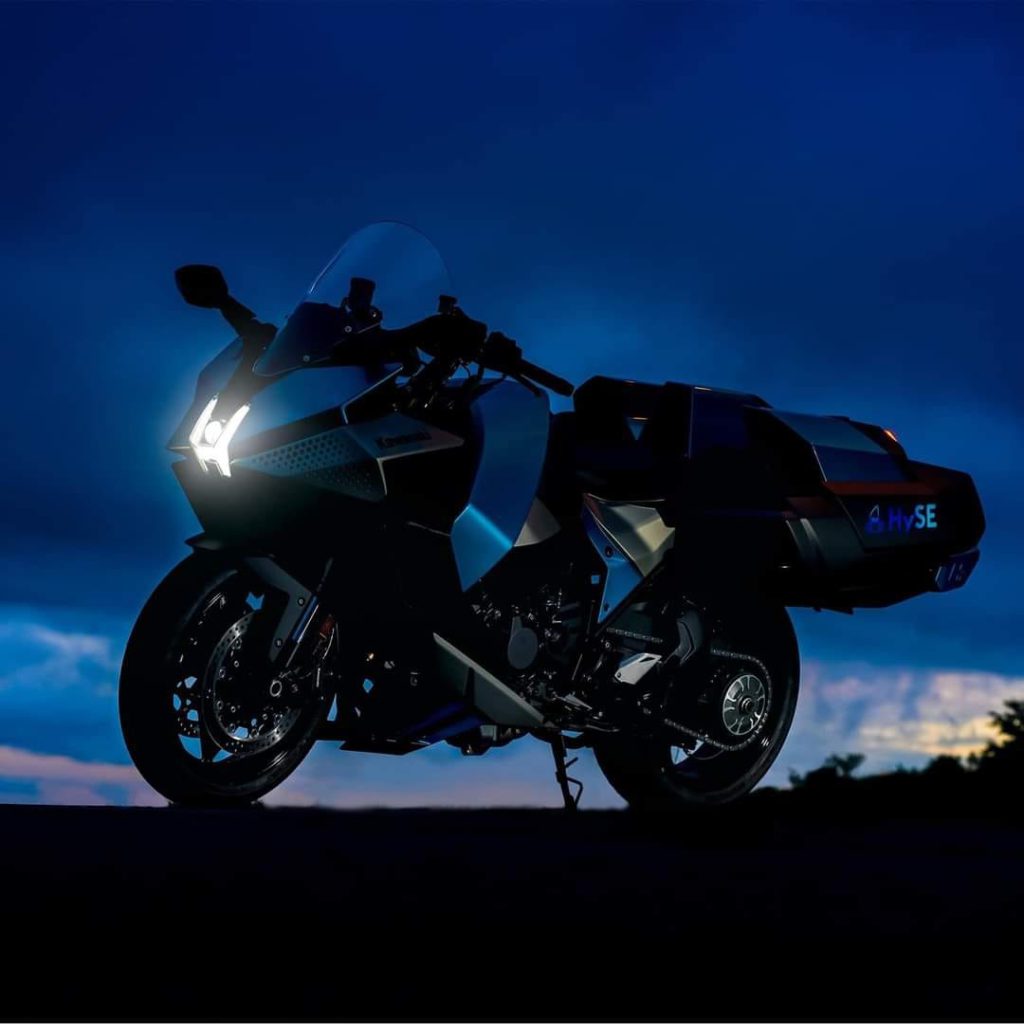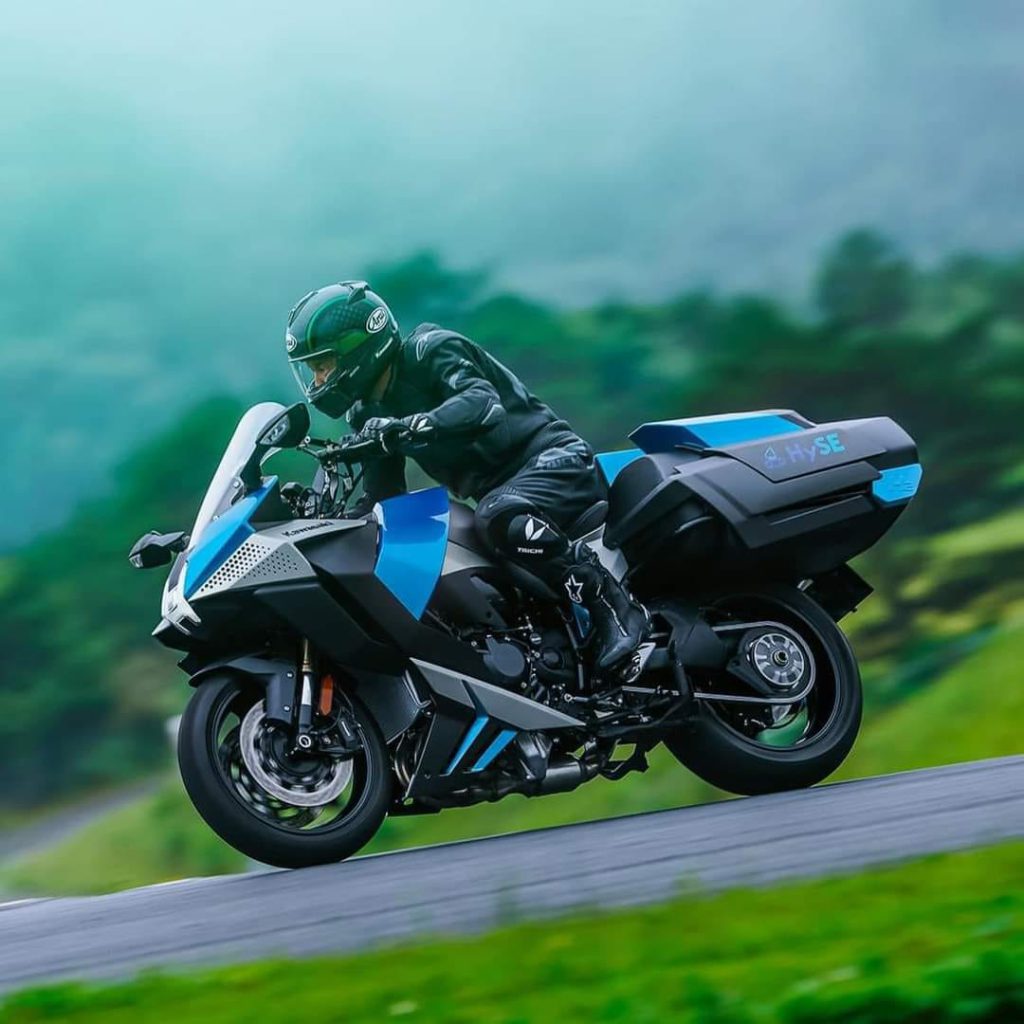In a groundbreaking move, Kawasaki unveiled their Ninja H2 SX-based ICE hydrogen motorcycle at the Suzuki 8 Hours endurance motorcycle race.
This event marked a historic moment as the world’s first public demonstration of a hydrogen internal combustion engine (ICE) motorcycle by a mass-market manufacturer.
Kawasaki’s innovative approach aims to redefine sustainable transportation in the motorcycle industry.
The Hydrogen ICE Motorcycle: A Revolutionary Prototype
The showcased prototype, known as the ‘Hydrogen ICE Motorcycle,’ represents a significant leap in motorcycle engineering.
This model is powered by a hydrogen engine based on Kawasaki’s 998cc, inline-four-cylinder, supercharged motor, which powers the Ninja H2 SX. However, instead of traditional fossil fuels, this engine utilizes hydrogen for combustion.
This shift to hydrogen is a critical step toward reducing the carbon footprint of motorcycles.
Engineering Marvel: The Hydrogen Engine
Significant Modifications for Hydrogen Combustion
To accommodate hydrogen as a fuel, substantial modifications have been made to the engine. T
he most notable change is the direct injection system, which allows hydrogen to be injected directly into the cylinders.
This adjustment is crucial for efficient hydrogen combustion, ensuring that the engine operates optimally.

Emissions and Environmental Impact
Unlike conventional ICE engines that emit harmful gases, the primary byproduct of Kawasaki’s hydrogen ICE engine is water, which is emitted as moist air from the exhaust canisters.
This significant reduction in harmful emissions positions the hydrogen ICE motorcycle as a cleaner alternative to traditional motorcycles, aligning with global efforts to combat climate change.
Design and Performance Enhancements
Chassis Design for Hydrogen Integration
Kawasaki has re-engineered the chassis to incorporate hydrogen tanks and the associated fuel supply system. This integration ensures that the motorcycle maintains its structural integrity and performance while accommodating the new fuel system.
The design also ensures that the additional components do not compromise the motorcycle’s handling or aesthetics.
Performance Metrics and Specifications
Although the exact specifications of the hydrogen ICE motorcycle are yet to be released, it is based on the supercharged engine of the Ninja H2 SX, which delivers 210 bhp and 137 Nm of torque.
Kawasaki claims that hydrogen combustion offers a faster burn rate across a wider temperature range, resulting in a more responsive and exhilarating riding experience.

The Hydrogen Mobility Initiative
Collaboration with Japanese Manufacturers
Kawasaki’s hydrogen mobility initiative is part of a broader collaboration under the Hydrogen Small Mobility & Engine Technology (HySE) venture.
The joint venture includes prominent Japanese manufacturers such as Honda, Yamaha, Suzuki, and Toyota. The collective goal is to develop and promote hydrogen as a viable and sustainable fuel for various mobility solutions.
Roadmap to Commercialization
Kawasaki plans to introduce hydrogen ICE motorcycles by the early 2030s. This timeline reflects the company’s commitment to advancing hydrogen technology and making it commercially viable.
The initiative aims to establish hydrogen as a mainstream fuel, providing a sustainable alternative to fossil fuels and reducing the environmental impact of transportation.
The Broader Impact of Hydrogen Technology
Advantages of Hydrogen as a Fuel
Hydrogen offers several advantages as a fuel source. It is abundant, can be produced from renewable sources, and its combustion results in minimal emissions.
These attributes make hydrogen an attractive option for reducing the carbon footprint of various industries, including automotive and transportation.
Challenges and Considerations
Despite its advantages, hydrogen technology faces several challenges.
These include the development of efficient hydrogen production methods, the establishment of a comprehensive refueling infrastructure, and the advancement of storage and handling technologies.
Addressing these challenges is crucial for the widespread adoption of hydrogen as a fuel.
The Future of Motorcycling: Embracing Innovation
Kawasaki’s Vision for Sustainable Mobility
Kawasaki’s unveiling of the hydrogen ICE motorcycle is a testament to the company’s vision for sustainable mobility. By pioneering hydrogen technology in motorcycles, Kawasaki is setting a new standard for innovation and environmental responsibility in the industry. T
his move reflects a broader trend towards embracing alternative fuels and developing eco-friendly transportation solutions.
Industry Implications and Prospects
The introduction of hydrogen ICE motorcycles could have far-reaching implications for the motorcycle industry. It presents an opportunity to reduce reliance on fossil fuels, lower emissions, and promote sustainable practices.
As more manufacturers explore hydrogen technology, the industry could witness a significant shift towards greener and more sustainable mobility solutions.
Conclusion: A New Era of Motorcycle Engineering
Kawasaki’s hydrogen ICE motorcycle represents a pivotal moment in the evolution of motorcycle engineering.
By harnessing the power of hydrogen, Kawasaki is not only advancing technological innovation but also contributing to a more sustainable future.
The hydrogen ICE motorcycle stands as a beacon of what’s possible when engineering excellence meets environmental consciousness.
As Kawasaki and other manufacturers continue to explore and develop hydrogen technology, the motorcycle industry is poised to enter a new era.
This era will be defined by sustainability, innovation, and a commitment to reducing the environmental impact of transportation. Kawasaki’s bold step into hydrogen technology sets a promising precedent, inspiring confidence in the potential of sustainable mobility solutions.


































